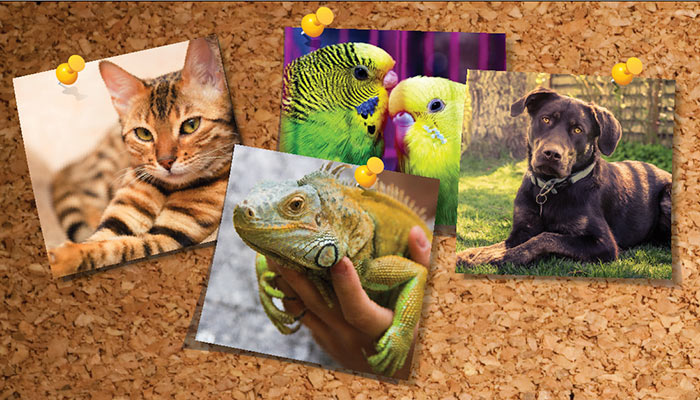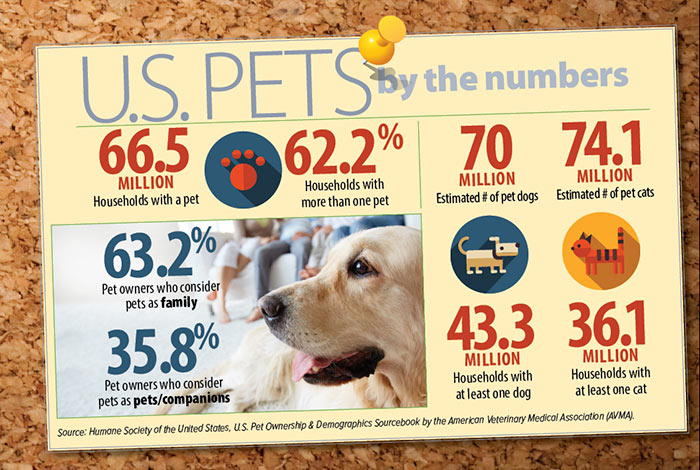
According to U. S. News & World Report, Americans spend over $60 billion annually on their pets. The average pet-owning household spends a little over $500 per year, which, interestingly, is more than the average household spends on alcohol.
Research shows that even when Americans were struggling during the recession of 2008 and 2009, they weren’t shorting their animals. They might have curtailed eating out in restaurants, but the money spent on pet food remained steady.
Companionship and unconditional love are often cited as reasons for having pets, but sharing your life with an animal isn’t just emotionally rewarding. There are also numerous health benefits attached—as if you needed another reason to bring home that adorable kitten or puppy.
Pets can help lower blood pressure, reduce depression, ease shyness, improve the immune system and inspire exercise. Enjoying time with a beloved animal elevates your levels of serotonin and dopamine, neurotransmitters known to boost feelings of happiness, pleasure and tranquility.
Studies have shown that pet owners have lower triglyceride and cholesterol levels, and heart attack survivors with pets live longer than those without. It’s even been noted that Alzheimer’s patients who have pets in the home will have fewer anxious outbursts.
Contrary to earlier beliefs, recent studies suggest that children growing up in a household with “furred animals” will have less risk of allergies and asthma than kids raised in a pet-free home.

If you don’t have a pet yet, how do you decide which one is right for your lifestyle?
“When making the decision to bring a pet into your home, there are certain factors to keep in mind such as the cost for care, need for space and the time commitment to appropriately care for the pet,” says Simon Starkey, DVM, resident veterinarian and pet care expert at PetSmart, Inc., the largest specialty pet retailer with over 1,400 stores.
It will help to consider the following… and be honest with your answers.
How much time will I realistically spend with an animal?
How much space do I have for a pet—inside and outside?
How much am I willing to put into caring for a pet—time-wise and financially?
Do I want “cuddly and furry” or less conventional?
Do I want an animal that requires lots of interaction or not so much?
If you rent, does the lease/landlord allow pets, and which kinds?
“Certain pets, especially certain dog breeds, require a significant amount of time as they need daily socialization and exercise,” says Dr. Starkey. “Cats tend to require a lower time commitment than dogs but still need attention and affection. Specialty pets like fish, guinea pigs, hamsters and birds all have varying requirements for care and the maintenance of habitats. However, on the whole, these pets tend to require less time than dogs, and some have a similar time commitment as cats. All pets should be afforded as much time by their pet parent and families for proper care.”
If you work full time, travel regularly for work or live in an apartment, you can still enjoy the rewards of having a pet. You just might want to consider one that is “lower maintenance,” such as aquarium fish, a “pocket pet” (gerbil, hamster, Guinea pig, etc.) or bird.
“While all pets require time and attention, fish—in particular Bettas—can make for excellent pets for those with limited available time to dedicate to pet care,” says Dr. Starkey. “Snakes and small pets, such as gerbils and hamsters, can also be a great choice for those with limited time and space, but these pets still require keeping a feeding and water schedule and, in some cases, daily interactions.”
If your family includes small children, you should probably rethink the idea of having a reptile for a pet, despite the “cool” factor of these animals.
“In general, reptiles may not be the best pet if you have young children in the home,” advises Dr. Starkey. “Not only do reptiles require moderately advanced care, such as specific heat, light and humidity requirements, as well as specialized food, reptiles have a higher propensity to carry Salmonella. The risk of human infection is greatly reduced with proper hand washing; however, younger children may not have the best hand-washing habits and this could increase the chance for infection.”
Although it sounds a bit morbid, you should also think about life span when considering which type of pet is best for you. Gerbils, rats and hamsters usually live two to three years, spayed or neutered house rabbits generally live eight to 12 years, while African gray parrots often live between 50 and 70 years.
Lower Maintenance
Cats
Aquarium fish
Parrots
Lovebirds
Guinea pigs
Rabbits
Reptiles
If you’ve decided to go the dog/cat route, your next decision is whether to get a puppy or kitten or go with an adult animal.
“Puppies and kittens can be irresistible. Families and individuals should be prepared for the extra time and effort for training, as well as patience for mistakes in the learning process and the overall mischievousness and rambunctious nature of puppies and kittens,” Dr. Starkey points out.
“Although all pets require time and attention, an adult pet with some basic training, such as potty training, may be a better fit for the busy family or individual,” he notes. “Adopting an adult pet can be a wonderful way for a family to do its part to help solve pet homelessness.”
Not only is there a wide variety of animals to choose from at an adoption shelter or rescue, but you also accomplish two things at once.
“When you adopt an animal, you are actually saving two lives—the one you adopt and the animal that can now be rescued and go into that vacated space and hopefully be adopted as well,” says Joanne Yohannan, Senior Vice President of Operations for the North Shore Animal League America, the world’s largest “no kill” animal rescue and adoption organization.
If you think shelters are full of down-on-their-luck, unwanted animals, think again.
“There are many beautiful animals available in local shelters or rescue groups that are in need of loving homes. There are many circumstances in which an animal may end up at a shelter, and typically, they are relinquished to these organizations as a result of circumstances beyond their control,” explains Yohannan. “Sometimes, owners have to move, there could be a divorce, illness or someone passes away. Lives change, and unfortunately, provisions might not have been made for the animals and they end up in shelters. There are also animals that require behavior modifications; however, many local shelters and rescue organizations work with the animal and provide the modification before they go up for adoption. Most animal shelters across the country will provide support and guidance for their adopters.”
Yohannan encourages potential adopters to make it a household affair and bring in everyone in the family when you go to a shelter or rescue group. The idea is to make sure everyone gets along with the animal. Be sure to allow plenty of time and, if necessary, plan a return trip. You want to be sure you spend enough time with the animal(s) you’re considering to get to know their personalities.
“Animal welfare has come a long way over the past two decades. The American people no longer accept euthanasia as a means of population control,” Yohannan points out. “We’ve gone from being a country that was euthanizing over 18 million animals a year to now euthanizing less than 3 to 4 million animals per year.
“There are many ways you can help prevent euthanasia in your community,” she adds. “Spaying or neutering will not only keep your pet healthy but also greatly reduces the overpopulation of unwanted litters. You can also volunteer at your local shelter, and when the time comes to add a pet to your family, always adopt rather than buy an animal. Social media platforms have given voices to homeless animals across the country, so make sure you use all of your social media platforms to give a voice to homeless animals in your community.”
Best Dogs For Families
It’s no surprise that dogs are called “man’s best friend.” The human-animal connection with a dog can be second-to-none. Although dogs generally require the most care and time of all domestic pets, when the match is right, the rewards far outweigh the extra effort. Experts give the following dog breeds high marks as a choice for families with children.
Golden Retriever: Smart, playful, loyal, very personable and people-oriented, doesn’t bark excessively
Labrador Retriever: One of the most popular breeds in the United States, fun-loving, energetic, playful, quick learner
Basset Hounds: Laid back and docile but loving, not hyper or easily excited
Collie: Playful, but protective, independent-minded, easily trained, gentle-natured
Beagles: Intelligent and easily trained, energetic and playful, great with kids, gentle, but protective
Bichon Frise: Smart and playful, energetic, doesn’t shed much, good choice if you want a small family dog
Poodle: Doesn’t shed, so good for families where allergies are a concern, friendly, patient, intelligent and loyal
Source: holisticpetcare.info
Where Pets Come From
37%Dogs adopted from a shelter or rescue
46%Cats adopted from a shelter or rescue
6%Dogs taken in as strays
27%Cats taken in as strays
4%Dogs purchased from a pet store
2%Cats purchased from a pet store
34%Dogs purchased from a breeder
3%Cats purchased from a breeder
Sources: Humane Society of the United States; APPA National Pet Owners Survey by the American Pet Products Association

U.S. Pets by the Numbers
70 millionEstimated number of pet dogs
74.1 millionEstimated number of pet cats
66.5 millionHouseholds with a pet
62.2%Households with more than one pet
43.3 millionHouseholds with at least one dog
36.1 millionHouseholds with at least one cat
63.2%Pet owners who consider pets as family
35.8%Pet owners who consider pets as pets/companions
Source: Humane Society of the United States, U.S. Pet Ownership & Demographics Sourcebook by the American Veterinary Medical Association (AVMA)






